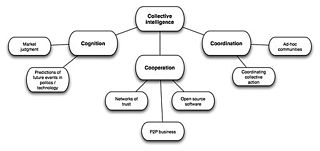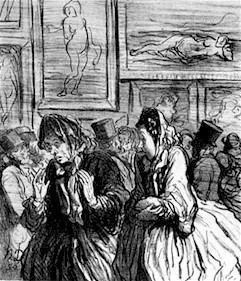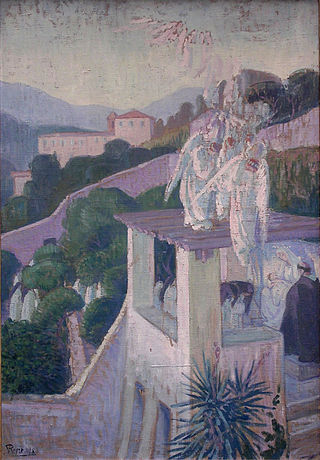
A cooperative is "an autonomous association of persons united voluntarily to meet their common economic, social and cultural needs and aspirations through a jointly owned and democratically-controlled enterprise". Cooperatives are democratically controlled by their members, with each member having one vote in electing the board of directors. Cooperatives may include:
Rebellion is a violent uprising against the state by the civilian population. A rebel is a person who engages in a rebellion. A rebel group is a consciously coordinated group that seeks to gain political control over an entire state or a portion of a state.

A collective is a group of entities that share or are motivated by at least one common issue or interest, or work together to achieve a common objective. Collectives can differ from cooperatives in that they are not necessarily focused upon an economic benefit or saving, but can be that as well.

Protest art is the creative works produced by activists and social movements. It is a traditional means of communication, utilized by a cross section of collectives and the state to inform and persuade citizens. Protest art helps arouse base emotions in their audiences, and in return may increase the climate of tension and create new opportunities to dissent. Since art, unlike other forms of dissent, take few financial resources, less financially able groups and parties can rely more on performance art and street art as an affordable tactic.

An art exhibition is traditionally the space in which art objects meet an audience. The exhibit is universally understood to be for some temporary period unless, as is occasionally true, it is stated to be a "permanent exhibition". In American English, they may be called "exhibit", "exposition" or "show". In UK English, they are always called "exhibitions" or "shows", and an individual item in the show is an "exhibit".

Folk art covers all forms of visual art made in the context of folk culture. Definitions vary, but generally the objects have practical utility of some kind, rather than being exclusively decorative. The makers of folk art are typically trained within a popular tradition, rather than in the fine art tradition of the culture. There is often overlap, or contested ground with 'naive art'. "Folk art" is not used in regard to traditional societies where ethnographic art continue to be made.

Self-Help Graphics & Art, Inc. is a community arts center in East Los Angeles, California, United States. The building is a mix Beaux-Arts and vernacular architecture built in 1927, and was designed by Postle & Postle. Formed during the cultural renaissance that accompanied the Chicano Movement, or Self Help, as it is sometimes called, was one of the primary centers that incubated the nascent Chicano art movement, and remains important in the Chicano art movement, as well as in the greater Los Angeles community, today. SHG also hosts musical and other performances, and organizes Los Angeles's annual Day of the Dead festivities. Throughout its history, the organization has worked with well-known artists in the Los Angeles area such as Los Four and the East Los Streetscapers, but it has focused primarily on training and giving exposure to young and new artists, many of whom have gone on to national and international prominence.
Marxian class theory asserts that an individual's position within a class hierarchy is determined by their role in the production process, and argues that political and ideological consciousness is determined by class position. A class is those who share common economic interests, are conscious of those interests, and engage in collective action which advances those interests. Within Marxian class theory, the structure of the production process forms the basis of class construction.

Asia Art Archive (AAA) is a nonprofit organisation based in Hong Kong which focuses on documenting the recent history of contemporary art in Asia within an international context. AAA incorporates material that members of local art communities find relevant to the field, and provides educational and public programming. AAA is one of the most comprehensive publicly accessible collections of research materials in the field. In activating its collections, AAA initiates public, educational, and residency programmes. AAA also offers research grants and publishes articles on IDEAS Journal.
Tulipamwe means "we are together" and is an independently funded artists project coordinated by the Tulipamwe Arts Trust in Namibia. The trust is organized under the auspices of the Visual & Performing Arts Department of the University of Namibia and is affiliated to the Triangle Network of Workshops initiated by Sir Robert Lauder.

A working group, is a group of experts working together to achieve specified goals. The groups are domain-specific and focus on discussion or activity around a specific subject area. The term can sometimes refer to an interdisciplinary collaboration of researchers working on new activities that would be difficult to sustain under traditional funding mechanisms.
The Vera List Center for Art and Politics is an American nonprofit research organization and public forum for art, culture, and politics, established in 1992. Vera List was an American art collector and philanthropist.
Feminist pedagogy is a pedagogical framework grounded in feminist theory. It embraces a set of epistemological theories, teaching strategies, approaches to content, classroom practices, and teacher-student relationships. Feminist pedagogy, along with other kinds of progressive and critical pedagogy, considers knowledge to be socially constructed.
The Boulevard House, now the Southwest Detroit Community House, is located in Southwest Detroit, Michigan and situated right on the Boulevard, in the articulation of Mexicantown, Mexican Village, and Hubbard Farms. It is the University of Michigan's settlement house, providing space for praxis among community scholars, community activists and residents. Since it was established in mid-2012, the Boulevard House has been used to create a place-based space to develop projects, engage community and support social change.

The Ateliers d'Art Sacré was a collective of artists based in Paris, France in the first half of the 20th century. It aimed to create religious art that was both modern and accessible to the general public. For nearly thirty years, this movement brought together a large number of artists dedicated to producing art in the service of the Catholic faith.
Social practice or socially engaged practice in the arts focuses on community engagement through a range of art media, human interaction and social discourse. While the term social practice has been used in the social sciences to refer to a fundamental property of human interaction, it has also been used to describe community-based arts practices such as relational aesthetics, new genre public art, socially engaged art, dialogical art, participatory art, and ecosocial immersionism.

An arpillera, which means burlap in Spanish, is a brightly colored patchwork picture made predominantly by groups of women. The construction of arpilleras became popular in Chile during the military dictatorship (1973–90) of Augusto Pinochet. Arpilleras were made in workshops organized by a committee of the Chilean Catholic Church and then secretly distributed abroad through the church's human rights group, the Vicariate of Solidarity. The production of arpilleras provided a vital source of income for the arpilleristas, many of whom had been left in a state of financial insecurity due to widespread unemployment and forced disappearances of their husbands and children, who became known as desaparecidos.
During World War II, the relations between art and war can be articulated around two main issues. First, art found itself at the centre of an ideological war. Second, during World War II, many artists found themselves in the most difficult conditions and their works are a testimony to a powerful "urge to create." Such creative impulse can be interpreted as the expression of self-preservation, a survival instinct in critical times.
Nha San Collective is the first and longest-running, non-profit, artist-run space for experimental art that was realized in the political scene in Vietnam. It has been a pioneer in facilitating an experimental art movement and in promoting contemporary culture.

Dayna Danger is a Two-Spirit/queer, hard femme, Métis/Saulteaux/Polish visual artist. Danger was born and raised in Winnipeg, Manitoba on Treaty 1 territory, and now resides in Tio'tiá:ke (Montréal). Danger explores various mediums in their creations including sculpture, photography, performance and video. Danger's work explores the relationships between representation, objectification, and empowerment. They also engage with themes of intimacy, gender, sexuality, BDSM, kink, and mixed identities. Danger's artwork from their Big'Uns series was on the front cover of the Summer 2017 Canadian Art Magazine issue. A white male curator once commented that he "could not see himself" in Danger's art, and Danger's response was that "[t]his work is not for you." Later, when Danger's photo from Big'Uns was made the cover of the issue, the editor's letter for the issue was titled "This Work Is Not For You". Collaboration and creating work for underrepresented groups are among Danger's major focuses. Danger uses singular they/them pronouns.










